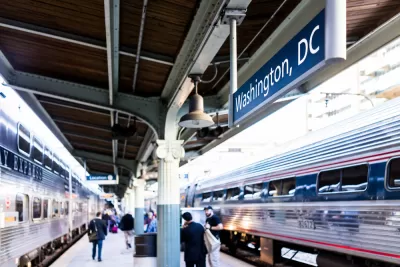The state's consistent investment in passenger rail has resulted in one of the nation's most effective regional rail networks.

As Virginia's commuter traffic grew increasingly worse, state officials bet on passenger rail as a solution, making the state a nationwide leader in rail service. "The quest to get more residents on trains has earned Virginia accolades and a national spotlight, particularly as new transportation priorities in Washington elevate multimodal travel with an eye on reducing greenhouse gas emissions," writes Luz Lazo in the Washington Post. In March of this year, Virginia Governor Ralph Northam "signed a $3.7 billion, wide-ranging deal with Amtrak, commuter rail operator Virginia Railway Express and freight railroad CSX, promising to double passenger service in the state within the decade and create a path to separate freight and passenger traffic."
The state's efforts have included direct involvement such as "purchasing hundreds of miles of passenger right of way from private railroads and negotiating agreements to expand service." Support of rail services, writes Lazo, has brought together Democrats and Republicans in rare agreement. "Whether they’re a Republican from Southwest or a Democrat from Hampton Roads, everybody has wanted to bring better rail service to their communities," says Daniel L. Plaugher, executive director of Virginians for High Speed Rail. "In 2011, under Gov. Bob McDonnell (R), Virginia became one of a handful of states to create a dedicated funding source for rail projects, using a percentage of the state’s retail sales and use tax." Virginia transportation secretary Shannon Valentine argues that reliable, effective rail service is a bipartisan win-win that will make the region "healthier, more connected and more competitive."
FULL STORY: Virginia is a rising leader in passenger rail. Here’s how it happened.

Study: Maui’s Plan to Convert Vacation Rentals to Long-Term Housing Could Cause Nearly $1 Billion Economic Loss
The plan would reduce visitor accommodation by 25,% resulting in 1,900 jobs lost.

North Texas Transit Leaders Tout Benefits of TOD for Growing Region
At a summit focused on transit-oriented development, policymakers discussed how North Texas’ expanded light rail system can serve as a tool for economic growth.

Using Old Oil and Gas Wells for Green Energy Storage
Penn State researchers have found that repurposing abandoned oil and gas wells for geothermal-assisted compressed-air energy storage can boost efficiency, reduce environmental risks, and support clean energy and job transitions.

Private Donations Propel Early Restoration of Palisades Playground
Los Angeles has secured over $1.3 million in private funding to restore the Pacific Palisades playground months ahead of schedule, creating a modern, accessible space that supports community healing after recent wildfires.

From Blight to Benefit: Early Results From California’s Equitable Cleanup Program
The Equitable Community Revitalization Grant (ECRG) program is reshaping brownfield redevelopment by prioritizing projects in low-income and environmental justice communities, emphasizing equity, transparency, and community benefits.

Planting Relief: Tackling Las Vegas Heat One Tree at a Time
Nevada Plants, a Las Vegas-based nonprofit, is combating the city’s extreme urban heat by giving away trees to residents in underserved neighborhoods, promoting shade, sustainability, and community health.
Urban Design for Planners 1: Software Tools
This six-course series explores essential urban design concepts using open source software and equips planners with the tools they need to participate fully in the urban design process.
Planning for Universal Design
Learn the tools for implementing Universal Design in planning regulations.
Ascent Environmental
Borough of Carlisle
Institute for Housing and Urban Development Studies (IHS)
City of Grandview
Harvard GSD Executive Education
Toledo-Lucas County Plan Commissions
Salt Lake City
NYU Wagner Graduate School of Public Service





























